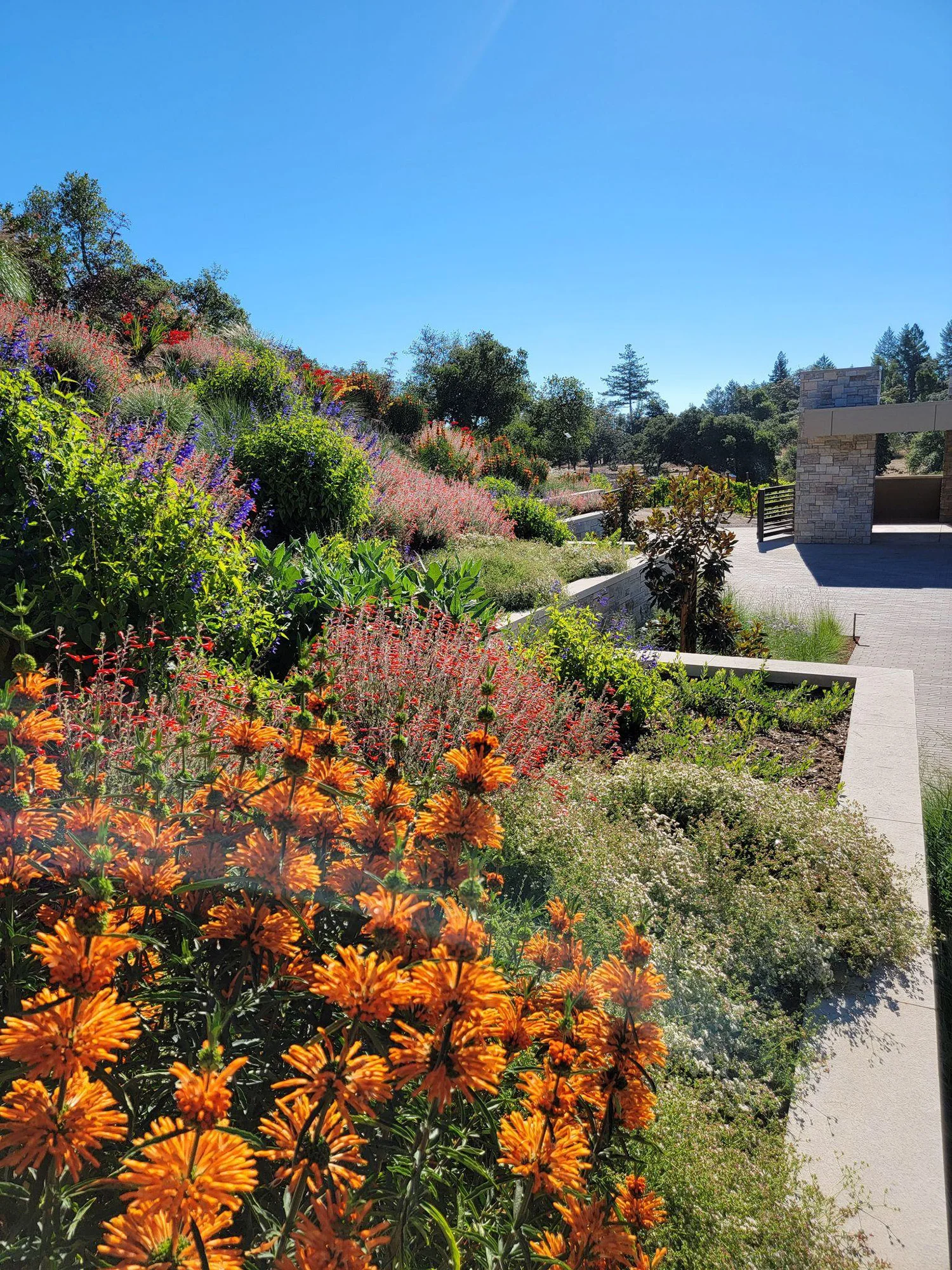
How Do I Prepare My Lawn and Landscape for Summer?
For most of us, summer is the peak season for a beautiful landscape, with flowers in bloom, shrubs lush with new growth, and lawns thriving after regeneration in spring. Yet ensuring that your lawn and landscape can thrive this summer can be more complicated than it seems. Many clients ask how we ensure the landscapes we manage are primed for summer performance! Here are some key actions we take, as the premiere landscape design consultants in Sonoma County, for all of our client’s lawns and landscapes to make the most of the summer season.
5 Quick Tips for Summer Lawn and Landscape Performance
TLDR, these quick tips can help you prep your lawn and landscaping for summer:
Water Smart
- Know your plants and their optimal irrigation cycles and water during cooler hours.
Mulch for Moisture & Health
- Apply mulch to retain moisture, reduce weeds, and improve soil health.
Adjust Lawn Care for Heat
- Fertilize in March and May with an organic nitrogen-rich formula and raise mower height to reduce moisture loss.
Prune at the Right Time
- Know the optimal time to prune your various plants and how much to prune.
Preventing Water Waste
- Use cycle-and-soak watering to ensure water absorption.
How Often Should I Water My Landscaping in the Summer?
Knowing when to water is essential for anything you grow. If your landscape is on drip irrigation and your lawn uses spray irrigation, consider these schedules:
Shrubs and Perennials
6-9 cycles per week
Lawns
Using 9-12 cycles per week
Trees
Approximately 4 cycles per week
Keep it Cool!
We always want to apply irrigation during cooler parts of the day between sunset and sunrise if possible. You can conserve water like a pro with these simple water saving techniques.
Know Your Root System Depth
The deeper plant roots grow, the less frequently you’ll need to water them. When a root system is shallow, it will require more frequent watering as the top layer of soil dries out more quickly than deeper layers of soil.
Deep Roots
Tree root systems seek water deep underground, with roots that extend down three to seven feet on average depending on the species.
Semi-Shallow Roots
Shrubs and perennials require more frequent watering as their root systems rarely extend further than a two or so feet into the ground.
Shallow Roots
Lawns have shallow root systems rarely reaching deeper than 6” so they require more frequent watering than others.

Make Sure to Prevent Run Off
Controlling run off is one of the most important questions for new landscape care. When irrigation applies water to the soil, it reaches the point of run off, meaning water runs away from where it is applied and ends up wasted or used by weeds. Clearly this isn’t the goal, so we always program irrigation to run cycles that end before runoff occurs. This happens much more quickly with sprinklers than it does with drip, so sprinkler cycles will be much shorter than drip.
The Cycle and Soak Method
Often this means we use multiple cycles per day to make sure we apply the water required by the plants, but that when we do, it is absorbed by the soil that is occupied by the roots of the plants we are irrigating. This method of irrigation is often referred to as ‘cycle and soak’, where water is applied to increase the holding capacity of the soil, then given a chance to rest, then a second cycle starts about an hour or two after (sometimes more) to apply the rest of the water.
Watering Schedule Example
A sample schedule could look like this;
Shrubs/Perennials
Monday, Wednesday, Friday
- Start times at 4am, 6am (25 minutes per cycle)
Lawns
Tuesday, Thursday, Friday, Saturday
- Start times at 3am, 4am, 5am (6 minutes per cycle)
Trees
Tuesday, Saturday
- Start times at 9pm,11pm (60 minutes per cycle)

How Should I Prepare Soil for Summer?
Mulching is one of the most important things to do to prepare soil for summer. Mulching increases water retention, reduces weeds, and feeds the soil. A mulch is any material that is laid over the soil surface and can include bark, compost, rock, or even materials such as rubber or polished glass.
Installing Mulch
Our preference is to use compost as mulch because it does far more for the health of the plants by feeding the soil important nutrients. Composting for your plants also contributes to the soil food web of fungi and bacteria that improve plant health, reduce pests and disease, and increase resilience to heat stress. Installing it in the fall in preparation for next summer is ideal because winter rain will wash nutrients deep into the soil and help build the soil food web.
Mulch Types
Bark mulch is also a great option, and we recommend using natural bark that isn’t dyed or treated with chemicals. This ensures the bark can break down over time and feed the soil similarly to compost mulch. Natural bark mulches provide far more benefit to the landscape than a dyed bark will. Ideally select a bark with varying size and texture such as ‘Arbor Mulch’ as it will hold its place better than a uniform chip mulch during activities such as raking, blowing, or other landscape maintenance.
How Should I Prepare My Lawn for Summer?
Proper fertilization, mowing height, and irrigation is essential for healthy lawns in the summer. Be certain to fertilize your lawns in March and May before the peak summer heat arrives using an organic nitrogen dominant fertilizer for green growth, and potassium for root development which helps make lawn care easy.
Mowing Height Adjustments
When summer arrives, adjust your mower to approx. 3-3.5” height for cool season grasses and approx 2-2.5” for warm season grasses. Most lawns in Sonoma County will be cool season grasses and setting your mower higher allows the soil in your lawn to retain moisture as it isn’t as exposed to summer heat. Cutting too low in the summer results in brown patchy lawns that require excessive irrigation to look moderately healthy.
Watering Your Lawn
Consistent and efficient irrigation is a hallmark of a healthy summer lawn. Make sure your sprinklers are adjusted for head to head coverage, nozzles are all matching precipitation rates, and all sprinklers are operating correctly without cracks or breaks.
Prevent Run Off
Lastly, going back to ways to conserve water in your landscape, programming your controller for a schedule similar to what we outlined in the first section of this blog will ensure you aren’t over or underwatering your lawn. Turning the sprinklers on for hours at a time simply wastes water and drowns the roots, strategic watering prevents soil compaction and keeps your lawn vibrant and green.
How Should I Prune My Plants for Summer?
Most pruning should take place in the winter and spring to ensure a vibrant summer garden. Here are some basic tips:
Perennials
Perennials should be cut back around March after the threat of frost has passed and then allowed to grow to their full size over the summer months without additional pruning.
Shrubs
Shrubs should be pruned in the spring to a size that will allow their summer growth plenty of room to grow in without needing additional pruning.
Fruit Trees
Fruit trees benefit from winter pruning during dormancy and pruning during summer should be limited to thinning of fruit and branches to improve the harvest.
Pruning Pro Tips
Generally heavy pruning during summer should never take place unless there is a serious need for corrective action as exposing undergrowth often leads to stress and burning under the summer heat. Being ahead of the game by pruning well ahead of the summer months is the ideal way to ensure your garden thrives during the peak season.
Transform Your Summer with Inspired Landscapes
Looking for a landscape design consultant in Sonoma County? You can ensure your landscape reaches its full potential this summer with the expertise of Inspired Landscapes! From precision irrigation programming and soil preparation to mulching, lawn care, and seasonal pruning, we bring years of experience to create and maintain thriving, stunning outdoor spaces.
Contact Inspired Landscapes today or give us a call at (707) 395-7474 to schedule a consultation and let us transform your outdoor space into a summer sanctuary you’ll love.

Owner, Inspired Landscapes LLC
Matthew Ripley is the owner of Inspired Landscapes LLC, a Healdsburg based landscape design, installation, maintenance, and irrigation firm serving Sonoma County. His work blends horticultural expertise with sustainable practices, drawing creative influence from Sierra backpacking and Sonoma winery estates to craft gardens that invite wildlife and year round color. Client testimonials highlight his design leadership on residential, estate, and winery properties across the region.





